
Messier 100 is a grand design intermediate spiral galaxy in the southern part of the mildly northern Coma Berenices. It is one of the brightest and largest galaxies in the Virgo Cluster and is approximately 55 million light-years from our galaxy, its diameter being 107,000 light years, and being about 60% as large. It was discovered by Pierre Méchain in 1781 and 29 days later seen again and entered by Charles Messier in his catalogue "of nebulae and star clusters". It was one of the first spiral galaxies to be discovered, and was listed as one of fourteen spiral nebulae by Lord William Parsons of Rosse in 1850. NGC 4323 and NGC 4328 are satellite galaxies of M100; the former is connected with it by a bridge of luminous matter.
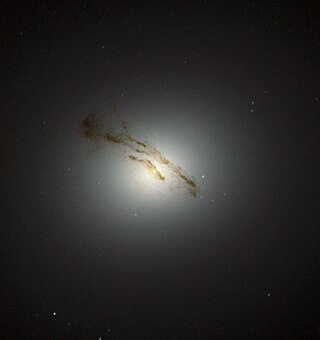
Messier 84 or M84, also known as NGC 4374, is a giant elliptical or lenticular galaxy in the constellation Virgo. Charles Messier discovered the object in 1781 in a systematic search for "nebulous objects" in the night sky. It is the 84th object in the Messier Catalogue and in the heavily populated core of the Virgo Cluster of galaxies, part of the local supercluster.
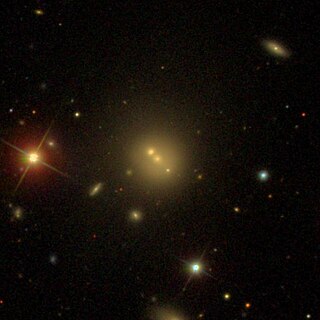
NGC 3550 is a lenticular galaxy in the constellation Ursa Major. It was discovered on April 11, 1785, by William Herschel. It is one of the brightest galaxies of the Abell 1185 galaxy cluster.
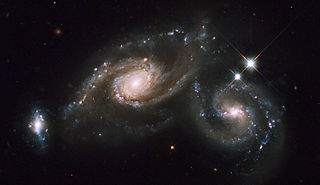
The NGC 5679 group, also known as Arp 274, is a triplet of galaxies, MCG+1-37-36, MCG+1-37-35 and MCG+1-37-34, spanning about 200000 light-years and at some 400 million light-years from Earth in the constellation Virgo. Arp 274 refers to the Atlas of Peculiar Galaxies, compiled by Halton Arp in 1966. Galaxies 269 through 274 in his catalogue are galaxies that appear to have connected arms.
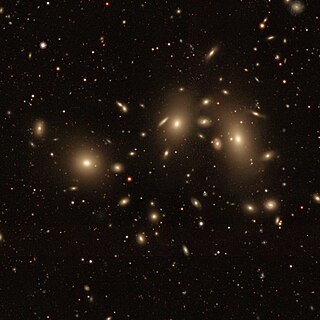
NGC 7499 is an unbarred lenticular galaxy within the constellation Pisces. NGC 7499 is its New General Catalogue designation. It was discovered on September 2, 1864 by the astronomer Albert Marth.

NGC 2748 is a spiral galaxy in the northern circumpolar constellation of Camelopardalis, located at a distance of 61.3 megalight-years from the Milky Way. It was discovered September 2, 1828 by John Herschel. The morphological classification of SAbc indicates this is an unbarred spiral with moderate to loosely-wound spiral arms. It is a disk-like peculiar galaxy with a stellar shell that is rotating about the main galactic axis. This shell was most likely formed through the capture and disruption of a dwarf companion. The galactic nucleus likely contains a supermassive black hole with a mass of 4.4+3.5
−3.6×107 M☉, or 44 million times the mass of the Sun.
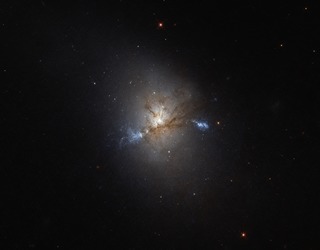
NGC 1222 is an early-type lenticular galaxy located in the constellation of Eridanus. The galaxy was discovered on 5 December 1883 by the French astronomer Édouard Stephan. John Louis Emil Dreyer, the compiler of the New General Catalogue, described it as a "pretty faint, small, round nebula" and noted the presence of a "very faint star" superposed on the galaxy.
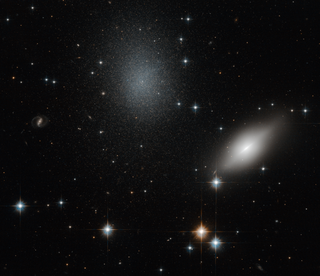
NGC 5011 is an elliptical galaxy in the constellation of Centaurus. It was discovered on 3 June 1834 by John Herschel. It was described as "pretty bright, considerably small, round, among 4 stars" by John Louis Emil Dreyer, the compiler of the New General Catalogue.

NGC 5559 is a barred spiral galaxy, located 240 million light-years away in the constellation of Boötes. It was discovered on April 10, 1785, by the astronomer William Herschel.

NGC 515, also occasionally referred to as PGC 5201 or UGC 956, is a lenticular galaxy located approximately 228 million light-years from the Solar System in the constellation Pisces. It was discovered on 13 September 1784 by astronomer William Herschel.

NGC 517, also occasionally referred to as PGC 5214 or UGC 960, is a lenticular galaxy located approximately 188 million light-years from the Solar System in the constellation Pisces. It was discovered on 13 September 1784 by astronomer William Herschel.

NGC 521, also occasionally referred to as PGC 5190 or UGC 962, is a barred spiral galaxy located approximately 224 million light-years from the Solar System in the constellation Cetus. It was discovered on 8 October 1785 by astronomer William Herschel.

NGC 525, also occasionally referred to as PGC 5232 or UGC 972, is a lenticular galaxy located approximately 95.6 million light-years from the Solar System in the constellation Pisces. It was discovered on 25 September 1862 by astronomer Heinrich d'Arrest.

NGC 4242 is a spiral galaxy in the northern constellation of Canes Venatici. The galaxy is about 18 million light years away. It was discovered on 10 April 1788 by William Herschel, and it was described as "very faint, considerably large, irregular, round, very gradually brighter in the middle, resolvable" by John Louis Emil Dreyer, the compiler of the New General Catalogue.

NGC 2300 is a lenticular galaxy in the constellation Cepheus. Its velocity with respect to the cosmic microwave background is 1876 ± 7 km/s, which corresponds to a Hubble distance of 90.2 ± 6.3 Mly (27.67 ± 1.94 Mpc). However, 11 non redshift measurements give a distance of 131.98 ± 21.75 Mly (40.464 ± 6.668 Mpc). The galaxy was discovered in 1871 by French astronomer Alphonse Borrelly using an 18 cm telescope.

NGC 2227 is a barred spiral galaxy with a morphological type of SB(rs)c located in the direction of the Canis Major constellation. It was discovered on January 27, 1835, by John Herschel.

NGC 996 is an elliptical galaxy of the Hubble type E0 in the constellation Andromeda. It is estimated to be 210 million light years from the Milky Way and has a diameter of approximately 75,000 ly. It was discovered on December 7, 1871 by astronomer Édouard Stephan.

NGC 2801 is a spiral galaxy in the constellation Cancer. Its velocity with respect to the cosmic microwave background is 8011 ± 20 km/s, which corresponds to a Hubble distance of 385.4 ± 27.0 Mly (118.16 ± 8.28 Mpc). It was discovered February 17, 1865, by Albert Marth.

NGC 3254 is a spiral galaxy in the constellation Leo Minor. It was discovered on March 13, 1785, by the astronomer William Herschel. It is a member of the NGC 3254 Group of galaxies, which is a member of the Leo II Groups, a series of galaxies and galaxy clusters strung out from the right edge of the Virgo Supercluster.

NGC 1819 is a lenticular galaxy in the constellation of Orion. It was discovered on December 26, 1885, by American astronomer Lewis A. Swift. This galaxy is located at a distance of 197.4 million light-years (60.53 Mpc) from the Milky Way, and is receding with a heliocentric radial velocity of 4,483 km/s.




















